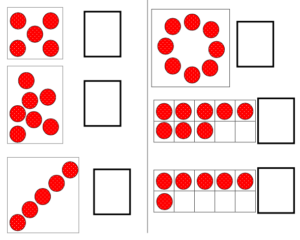MAFS.K.CC.2.4:
Understand the relationship between numbers and quantities; connect counting to cardinality.
a. When counting objects, say the number names in the standard order, pairing each object with one and only one number name and each number name with one and only one object.
b. Understand that the last number name said tells the number of objects counted. The number of objects is the same regardless of their arrangement or the order in which they were counted.
c. Understand that each successive number name refers to a quantity that is one larger.
Video Example – “Cardinal Cup”Related Task
Cognitive Complexity Level: 1-Recall
[divider] [/divider] Students are able to…
- Say number names in consecutive order while pointing to each object.
- Recognize that no matter how items are arranged and rearranged, the amount remains the same.
- Indicate “how many” are in a group without recounting the whole group.
- Add one item to count on items in a set and ultimately count up one mentally.
[divider] [/divider] Students are able to…because teachers:
- Provide opportunities for students to count using a variety of objects (i.e. coins, counters, buttons).
- Progress from organized, linear representations to random arrangements.
- Reinforce that the last number name tells the count by asking questions such as, “How many are there?”
[divider] [/divider] Questions to ask students:
- Did you count each object only once?
- Is there a way to know if you have already counted an object?
- How do you know where you started counting and where you stopped?
- Show students a collection of objects arranged in a line and ask students, “How many do you think there are?” Ask students to count the objects and follow up with, “How many are there?” Use same collection of objects to arrange randomly. Ask students, “How many are there?”
- Sample answer that indicates understanding: Students keep track of objects counted, identifies the last number stated as the total number counted, and correctly counts objects in a line and in random arrangement.
- Sample answer that indicates an incomplete understanding or a misconception: Students skip number names in standard order or does not keep track of objects counted.
[divider] [/divider] Additional Resources:
Additional in depth content knowledge
Blog Post:
Still struggling with counting?
Video:
Teaching the cardinal counting principle
[divider] [/divider] Sample Formative Assessment Tasks:
Count the dots in each picture. Write the numeral that tells how many dots in the box beside the picture.
[divider] [/divider] Resources/Tasks to Support Your Child at Home
- Use number cards (0-4). Flip over a card and have your child name the next card in the sequence. For example, if you flip over a two, ask your child, “What number comes after two?”
- LearnZillion Video: Find one more than the number of objects in a set https://goo.gl/6rpbNE
- Using no more than 5 stickers, have your child place them on a piece of paper and count each sticker as they place them on the paper. After they have placed all the stickers on the paper, encourage them to identify the total number of the paper.
- LearnZillion Video: The last number said tells the number counted https://goo.gl/mzUFHL
